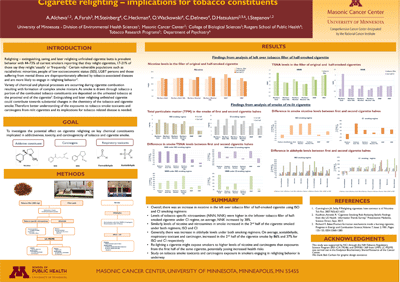Alcheva Aleksandra
PhD, Environmental Health
Co-Authors:
Michael Steinberg, Carolyn Heckman, Olivia Wackowski, Irina Stepanov
Advisor:
Dr. Irina Stepanov
Educational Objectives:
To investigate the potential effect on cigarette relighting on key chemical constituents implicated in addictiveness, toxicity, and carcinogenicity of tobacco and cigarette smoke.
Keywords:
Harmful tobacco constituents, Exposures from relit cigarettes
Abstract
Background: Extinguishing and relighting cigarettes is a relatively unexplored smoking behavior. Certain sub-populations such as women, African-Americans, unemployed, and menthol smokers are more likely to engage in this behavior. Moreover, relighting cigarettes is associated with increased lung cancer risk and higher rates of chronic bronchitis. We aimed to measure tobacco alkaloids and tobacco-specific nitrosamines (TSNA) in the tobacco filler of half-smoked cigarettes to assess whether smoking a re-lit cigarette may lead to higher exposures to these constituents than the first half of the same cigarette.
Methods: Levels of nicotine, minor alkaloids and TSNA were measured in Marlboro Gold and Menthol cigarettes (both in king-size and 100s version) by our validated methods. We used two smoking regimens (ISO and Canadian Intense, CI), and the levels of constituents were measured in the original tobacco filler, and in tobacco filler of half-smoked cigarette. Each cigarette was smoked and analyzed in duplicate.
Results: Compared to the levels measured in the tobacco filler of unburned cigarette, nicotine in the filler of half-smoked cigarettes generally increased by approximately 8% under both ISO and CI regimens. Levels of nornicotine, anatabine, and anabasine generally decreased, particularly after CI smoking. Levels of NNK, a carcinogenic TSNA, consistently increased in all brands tested, the increase ranging from 23% to 199% under CI conditions. Changes in levels of NNN, another carcinogenic TSNA, were not consistent. Generally, results differed by smoking intensity and by individual brand; however there was no apparent effect of cigarette length or menthol. Correction for moisture content of the filler in a subset of samples showed further increase in constituent levels.
Conclusion: Higher levels of some important harmful constituents in tobacco filler of half-smoked cigarette may lead to higher levels of these constituents in smoke when the cigarette is relit. Further research is warranted to better understand the effect of cigarette relighting on harmful exposures and relevant health outcomes in smokers who are engaging in this practice.
Support
This study was supported by NCI through the NIH Tobacco Regulatory Science Program (R01-CA179246) and UMF0011369 from UMN.

View Poster (PDF)
